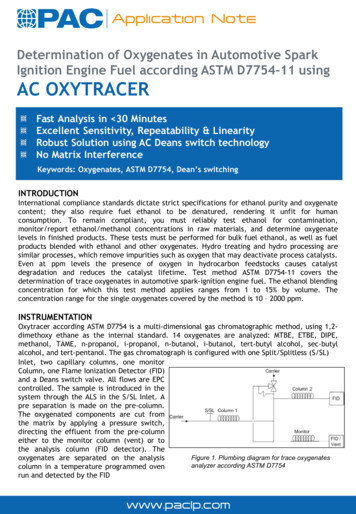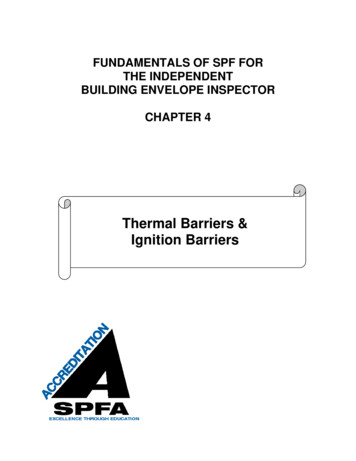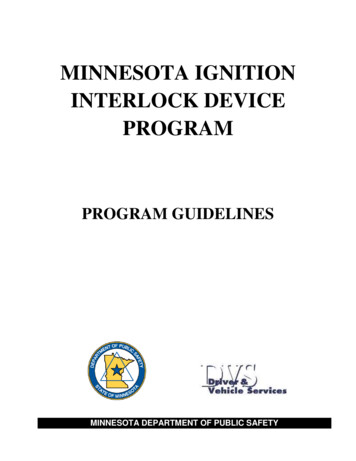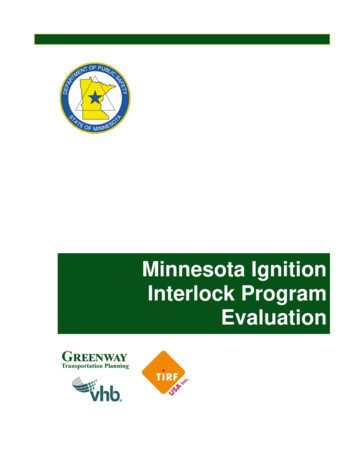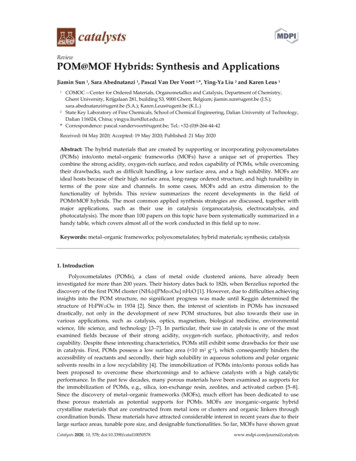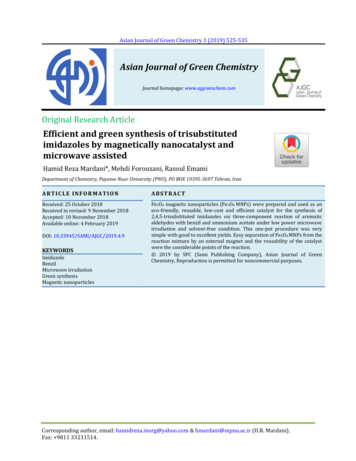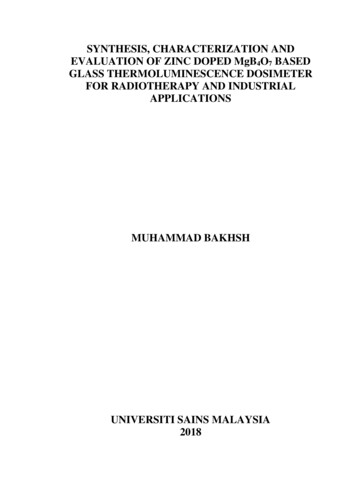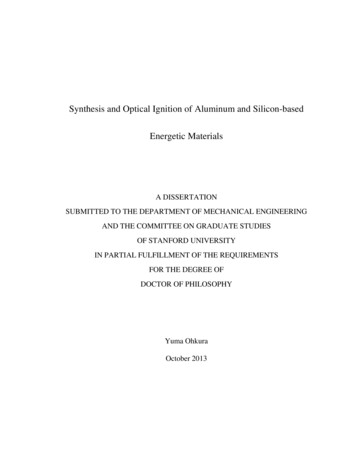
Transcription
Synthesis and Optical Ignition of Aluminum and Silicon-basedEnergetic MaterialsA DISSERTATIONSUBMITTED TO THE DEPARTMENT OF MECHANICAL ENGINEERINGAND THE COMMITTEE ON GRADUATE STUDIESOF STANFORD UNIVERSITYIN PARTIAL FULFILLMENT OF THE REQUIREMENTSFOR THE DEGREE OFDOCTOR OF PHILOSOPHYYuma OhkuraOctober 2013
2013 by Yuma Ohkura. All Rights Reserved.Re-distributed by Stanford University under license with the author.This work is licensed under a Creative Commons AttributionNoncommercial 3.0 United States 3.0/us/This dissertation is online at: http://purl.stanford.edu/yw312xw5478ii
I certify that I have read this dissertation and that, in my opinion, it is fully adequatein scope and quality as a dissertation for the degree of Doctor of Philosophy.Xiaolin Zheng, Primary AdviserI certify that I have read this dissertation and that, in my opinion, it is fully adequatein scope and quality as a dissertation for the degree of Doctor of Philosophy.Mark BrongersmaI certify that I have read this dissertation and that, in my opinion, it is fully adequatein scope and quality as a dissertation for the degree of Doctor of Philosophy.Alberto SalleoApproved for the Stanford University Committee on Graduate Studies.Patricia J. Gumport, Vice Provost for Graduate EducationThis signature page was generated electronically upon submission of this dissertation inelectronic format. An original signed hard copy of the signature page is on file inUniversity Archives.iii
AbstractEnergetic materials, aluminum (Al) and silicon (Si), due to their largevolumetric energy densities, earth abundance, and low cost, have broad applications inpropulsion, thermal batteries, waste disposal and power generation for microsystems.The energetic materials are commonly prepared by mixing fuel and oxidizer powders,however, the energy release rates are slow and difficult to ignite. Furthermore, thelarge portion of the reactants remains unburned due to the formation of the oxide layerduring the reaction. Optimized energetic materials would have the reactivecomponents mixed on a scale as fine as possible to reduce the mass transport distanceand facilitate the ignition. This leads to the idea of reducing the sizes of energeticmaterials down to nanoscale to increase the surface area and contact area between thefuel and oxidizer. In this study, we investigated two new areas: 1) the effects of thenanostructured morphology on the exothermic reaction of Al and CuO, 2) demonstrateand understand the flash ignition of Al nanoparticles (NPs), and extending the flashignition to Al microparticles (MPs) and porous Si.First, it remains a challenge to create energetic materials, a mixture of Al andmetal oxides, with nanoscale uniformity. Here, we report synthesis and ignitionstudies on thermites (mixtures of Al and metal oxides) with unique nanostructures, i.e.,CuO/Al core/shell nanowires (NWs) and Al/CuO core/shell micro and nano particles.The CuO NW cores were synthesized by the thermal annealing of copper films andiv
served as templates for the deposition of Al shells by subsequent sputtering. Similarly,for core/shell particles, the Al particles were coated with a very thin CuO shell using asolution phase method. The advantage of such core/shell structures are that CuO andAl are uniformly mixed at the nanoscale with no aggregation. The onset temperaturesof the exothermic reaction of the core/shell NWs were similar to those of nanoparticleNP-based thermites in terms of magnitude, and insensitivity to equivalence ratios.Moreover, the core/shell NW thermites, compared to NP-based thermites, exhibitgreatly improved mixing uniformity and reduced activation energy for the thermitereaction. For Al/CuO core/shell particles, in comparison to mixtures of Al particlesand CuO NPs, have better chemical homogeneity and physical contact between Al andCuO, so that the core/shell particles exhibit much larger burning rates. The core/shellstructure is a general and effective structure to tailor the combustion performance ofenergetic materials.Second, nonintrusive optical flash ignition is attractive for many applicationsdue to its simplicity, and flexibility in controlling the area exposed to the flash.However, the oxidation mechanism of Al NPs at large heating rates remainsinconclusive due to the lack of direct experimental evidence. We studied the oxidationmechanism of Al NPs under large heating rate (on the order of 106 K/s or higher) by asimple flash ignition method, which uses a xenon flash to ignite Al NPs. The flashignition occurs when the Al NPs have suitable diameters and sufficient packingdensity to increase the temperature above their ignition temperatures. We thenv
extended the flash ignition to Al MPs. Flash ignition of Al MPs is challenging due totheir higher minimum flash ignition energy, which originates from weaker lightabsorption and higher ignition temperature compared to Al NPs. By the addition ofWO3 NPs to Al MPs, the minimum flash ignition energy of Al MPs was reduced andwe studied the roles of WO3 NPs upon flash ignition. Finally, we demonstrate thatfreestanding porous Si films can also be optically ignited in ambient air by a xenonflash. Our complementary experimental and numerical studies reveal that theminimum flash ignition energy increases with increasing the thickness due to heat lossthrough the porous Si layer. The minimum flash ignition energy is lower for higherporosity Si film since higher porosity reduces the heat capacity and thermalconductivity, facilitating the temperature rise. We believe that these results will be ofgreat importance to reliably ignite energetic materials and to prevent unwantedcombustion for practical energetic applications.vi
AcknowledgementI would like to express my deep appreciation to my research advisor, Prof.Xiaolin Zheng, for her generous guidance, support and encouragement throughout myPh.D. program at Stanford. She was constantly available for scientific discussions, andshe is definitely one of my greatest role models as a professor. Her continuous andambitious working attitude will always remind me the importance to work hard toovercome my future challenges in my career. I would like to thank her for teaching methe importance of writing/presentation skills, and for strongly cheering me throughoutmy Ph.D. program. I feel very fortunate to have Prof. Xiaolin Zheng as my advisor.I would also like to thank, Prof. Mark Brongersma, Prof. Alberto Salleo, Prof.Tom Bowman and Prof. Debbie Senesky for serving as my defense committee. Theircomments and suggestions at my defense encouraged me to think deeper and providedme a different perspective towards my research. In particular, I would like to thankProf. Mark Brongersma and Prof. Alberto Salleo for their time reading my thesis.I gratefully appreciate all the group members in the Zheng Research Group fortheir generous support. Dr. Dong Rip Kim, Dr. Yunzhe Feng, Dr. Pratap Rao, Dr. ChiHwan Lee, Dr. Jeffery Weisse, Dr. In Sun Cho, and Dr. Hong Li gave me veryvii
valuable feedback on my research and presentations. I also thank Shih-Yu Liu, LiliCai, Runlai Luo. Working with them was one of my best moments in my academic life.I would like to acknowledge the supportive Stanford lab staff members as well.Especially, Bob Jones for his assistance in SEM-EDS, Lakhbir Johal for machiningmy experimental parts, and Dr. Guangchao Li for running the ICP measurements.I gratefully acknowledge the financial support from the Japan Student ServiceOrganization for supporting my tuition and living expenses. Without the financialsupport, I would not be able to afford to study at Stanford University.Last but not least, I would like to thank my parents and sister for their financialand mental support. I would not be able to progress through my Ph.D. degree withouttheir help. I really cannot thank them enough for their continuous support.viii
Table of Contents1.2.Introduction . 11.1.Definitions and motivations . 11.2.Background on nanoenergetics . 21.2.1.Materials for nanoenergetics . 21.2.2.The size dependence on the combustion and ignition of Al . 31.2.3.Non-diffusional combustion mechanism: Melt-Dispersion Mechanism 101.2.4.Ignition and combustion studies on porous Si . 111.2.5.The effect of morphology and porosity on burning rate of porous Si . 131.3.Opportunities and challenges . 151.4.Objectives and organization of the thesis . 16Synthesis of energetic materials: CuO/Al core/shell nanowires, Al/CuO core/shellparticles, and porous Si film . 182.1.Background on core/shell nanoscale thermites . 182.2.Background on hydrogenated porous Si energetics . 202.3.Synthesis and characterization of core/shell structured materials . 222.3.1.Synthesis and characterization of CuO/Al core/shell nanowires . 222.3.2.Synthesis and characterization of Al/CuO core/shell particles . 252.4.Synthesis of freestanding porous Si film . 29ix
2.5.3.Enhanced exothermic reaction of core/shell structured materials . 323.1.Experimental specifications . 323.1.1.Differential scanning calorimetry . 323.1.2.X-ray diffraction analysis . 343.1.3.Burning rate measurement . 353.2.Exothermic reaction of CuO/Al core/shell nanowires . 363.2.1.Effect of the Al layer thickness . 363.2.2.Effect of heating rate . 383.2.3.Comparison of nanowire- and nanoparticle-based thermites . 413.3.Enhanced combustion of Al/CuO core/shell particles . 443.3.1.Effect of structure on the onset temperature. 453.3.2.Effect of the core/shell structure on the burning rates . 463.4.4.Conclusion . 31Conclusion . 47Flash ignition of Al particles and addition of WO3 nanoparticles . 494.1.Background . 494.2.Experimental specifications . 504.2.1.Flash ignition experimental setup . 504.2.2.Material preparation of Al nanoparticles and mixtures of Almicroparticles/WO3 nanoparticles . 52x
4.3.Flash ignition of Al particles . 544.4.Material characterization of Al and WO3 particles . 564.4.1.X-ray diffraction characterization of products of Al MPs and WO3 NPs564.5.Estimation of the temperature increase of single and multiple Al particles . 574.5.1.Estimation of the temperature increase of single Al particles . 574.5.2.Estimation of the temperature increase of multiple Al particles . 594.6.Al nanoparticle oxidation mechanism . 614.7.Reducing minimum flash ignition energy of Al microparticles by addition ofWO3 nanoparticles . 654.7.1.Minimum flash ignition energy of the mixture of Al MPs and WO3 NPs654.7.2.Optical characterizations of Al MPs with addition of WO3 nanoparticles664.8.5.Conclusion . 68Flash ignition of freestanding porous Si film . 705.1.Background . 705.2.Flash ignition of porous Si film . 715.2.1.Experimental setup and flash ignition process of Si film . 715.2.2.Minimum flash ignition energy of porous Si film . 73xi
5.2.3.5.3.Estimation of the temperature increase of a porous Si film . 75Conclusion . 826.Conclusion . 837.Recommendation for future work . 867.1.Oxidation kinetics studies of thermite mixtures using the Micro-ThermalStage 867.2.8.Engineering application of flash ignition: Airbag igniter . 89Bibliography . 91xii
List of TablesTable 1: The effect of film thickness on burning rate. [24]. 13Table 2: The effect of porosity on burning rate. [24] . 14Table 3: Parameters and values of porous Si used in the COMSOL simulation. . 78xiii
List of FiguresFigure 1-1: Gravimetric and volumetric heat of oxidation of inorganic energeticmaterials. [2] . 3Figure 1-2: Schematic representation of the flame structures observed in aluminumcombustion. [6] . 4Figure 1-3: Experimetal data of Al particle burning time as a function of particlediameter. [7] . 6Figure 1-4: The Al size effect on ignition temperatures. [8] . 6Figure 1-5: Phase change process of the Al particle surface with respect to temperatureand TGA curve. [9]. 8Figure 1-6: Ignition temperature predicted by multiple aluminum oxide polymorphsmodel as a function of particle size. [12] . 9Figure 1-7: Schematic of non-diffusional combustion mechanism: Melt-DispersionMechnaism. [13] . 10Figure 1-8: Schematic of the initiation of explosive reaction between the hydrogenatedporous Si and cryogenic oxygen. [22] . 12Figure 2-1: (a) The reaction pathways of porous Si formation etching andelectropolishing. (b) The lift-off mechanism for undercutting of a porous Si layer. [56]. 21Figure 2-2: a) Schematics of the fabrication process of the CuO/Al core/shell NWs.The insets are the corresponding optical images. SEM images of the b) CuO NWs, c)xiv
CuO/Al (250 nm) core/shell NWs, and d) enlarged view of c). The yellow dashed linesoutline each core/shell nanowire. . 22Figure 2-3: Effect of the growth time on the morphology of the CuO NWs annealed at500 oC. SEM images of NWs grown for a) 5 hours and b) 24 hours. The inset showsthat the CuO NWs are connected to the underneath CuO layer. . 24Figure 2-4: a) Schematics of the synthesis process of the Al/CuO core/shell particles.TEM images of the b) initial Al particles, c) Al/CuO core/shell particle, and d)enlarged view of c). . 26Figure 2-5: a) TEM image of the Al/CuO core/shell MP. b) and c) EDS elementalmapping images of Cu and O. . 28Figure 2-6: (a) Cross-sectional schematic of an anodization cell used for the porous Siformation, and electropolishing. [63] (b) Cross-sectional SEM image of the porous Silayer formed over the Si wafer. . 30Figure 3-1: The DSC calibration curve measuring the heat of fusion of KBr (56.85mg). The integrated area under the heat of fusion curve is 51.956 Vs/g. . 33Figure 3-2: Parallel beam XRD of CuO/Al (250nm) core/shell NWs a) before and b)after the DSC test. 34Figure 3-3: a) Schematic and b) optical image of the microchannel device for burningrate measurement. The thermite reaction propagates across the microchannelassociated with the visible emission, which was collected by the photo-diode throughan equally-spaced array of optical fibers. . 35xv
Figure 3-4: DSC traces for reactions of the CuO/Al core/shell NWs with different Alshell thickness (100 nm, 250 nm, and 425 nm). All the traces were recorded in inertHe at a heating rate of 5 oC/min. . 37Figure 3-5: a) DSC traces for reactions of the CuO/Al (250nm) core/shell NWs atheating rates of 5 oC/min, 15 oC/min, 25 oC/min and 40 oC/min. b) The exothermiconset temperatures of the CuO/Al core/shell NWs at different heating rates. . 39Figure 3-6: Thermal analysis of DSC traces for the CuO/Al (250 nm) core/shell NWs,and CuO/Al NPs at equivalence ratios of 1.00 and 0.24. . 40Figure 3-7: Comparison of DSC traces for reactions of CuO/Al (425nm) core/shellNWs, a stoichiometric mixture of CuO NWs and Al NPs, and a stoichiometric mixtureof CuO and Al NPs. . 42Figure 3-8: Comparison of DSC traces for reactions of Al/CuO core/shell (a) NPs and(b) MPs vs. mixtures of Al NPs and CuO NPs with same equivalence ratio (Ф 6.3,8.1). . 46Figure 3-9: Photo-diode signal voltages as a function of time for Al/CuO core/shell (a)NPs and (b) MPs compared to Al/CuO powder mixtures at equivalent stoichiometry.The peak signal voltage
volumetric energy densities, earth abundance, and low cost, have broad applications in propulsion, thermal batteries, waste disposal and power generation for microsystems. The energetic materials are commonly prepared by mixing fuel and oxidizer powders, however, the energy release rates are slow a
